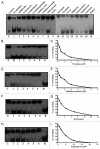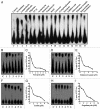Inhibition of unwinding and ATPase activities of Plasmodium falciparum Dbp5/DDX19 homolog
- PMID: 21980563
- PMCID: PMC3187891
- DOI: 10.4161/cib.4.3.14778
Inhibition of unwinding and ATPase activities of Plasmodium falciparum Dbp5/DDX19 homolog
Abstract
We have recently reported the isolation and characterization of Plasmodium falciparum Dbp5/DDX19 homolog PfD66 and the results indicate that it contains ATP-dependent bipolar DNA and RNA unwinding activity, intrinsic nucleic acid-dependent ATPase and RNA-binding activities. In the present study we report the effect of a number of compounds such as actinomycin D, aphidicolin, camptothecin, cyclophosphamide, 4',6'-di-amidino-2-phenylindole (DAPI), daunorubicin, distamycin, ethidium bromide, ellipticine, genistein, mitoxantrone, nalidixic acid, netropsin, nogalamycin, novobiocin and VP-16 on the DNA unwinding and ATPase activities of PfD66. The results indicate that DAPI, ethidium bromide, netropsin and nogalamycin efficiently inhibited the helicase and ATPase activities of PfD66. These studies will make an important contribution in understanding the mechanism of DNA unwinding by Plasmodium falciparum helicase PfD66.
Keywords: ATPase; DNA-binding agents; Plasmodium falciparum; helicase; malaria parasite.
Figures


Comment on
-
A novel dual Dbp5/DDX19 homologue from Plasmodium falciparum requires Q motif for activity.Mol Biochem Parasitol. 2011 Mar;176(1):58-63. doi: 10.1016/j.molbiopara.2010.12.003. Epub 2010 Dec 17. Mol Biochem Parasitol. 2011. PMID: 21168450
Similar articles
-
Inhibition of unwinding and ATPase activities of pea MCM6 DNA helicase by actinomycin and nogalamycin.Plant Signal Behav. 2011 Mar;6(3):327-9. doi: 10.4161/psb.6.3.13355. Epub 2011 Mar 1. Plant Signal Behav. 2011. PMID: 21336027 Free PMC article.
-
Inhibition of DNA unwinding and ATPase activities of human DNA helicase II by chemotherapeutic agents.Biochem Biophys Res Commun. 1997 Jul 30;236(3):636-40. doi: 10.1006/bbrc.1997.7021. Biochem Biophys Res Commun. 1997. PMID: 9245703
-
Inhibition of pea chloroplast DNA helicase unwinding and ATPase activities by DNA-interacting ligands.Biochem Biophys Res Commun. 1998 Mar 27;244(3):861-7. doi: 10.1006/bbrc.1998.8363. Biochem Biophys Res Commun. 1998. PMID: 9535757
-
Unraveling the importance of the malaria parasite helicases.FEBS J. 2017 Aug;284(16):2592-2603. doi: 10.1111/febs.14109. Epub 2017 May 29. FEBS J. 2017. PMID: 28500788 Review.
-
Drug-DNA sequence-dependent interactions analysed by electric linear dichroism.J Mol Recognit. 1992 Dec;5(4):155-71. doi: 10.1002/jmr.300050406. J Mol Recognit. 1992. PMID: 1339484 Review.
Cited by
-
Inhibitory effects of anthracyclines on partially purified 5'-3' DNA helicase of Plasmodium falciparum.Malar J. 2022 Jul 11;21(1):216. doi: 10.1186/s12936-022-04238-y. Malar J. 2022. PMID: 35821133 Free PMC article.
-
Dbp5/DDX19 between Translational Readthrough and Nonsense Mediated Decay.Int J Mol Sci. 2020 Feb 6;21(3):1085. doi: 10.3390/ijms21031085. Int J Mol Sci. 2020. PMID: 32041247 Free PMC article. Review.
-
Characterization of Plasmodium falciparum ATP-dependent DNA helicase RuvB3.Malar J. 2016 Nov 3;15(1):526. doi: 10.1186/s12936-016-1573-2. Malar J. 2016. PMID: 27809838 Free PMC article.
-
DEAD/DExH-Box RNA Helicases in Selected Human Parasites.Korean J Parasitol. 2015 Oct;53(5):583-95. doi: 10.3347/kjp.2015.53.5.583. Epub 2015 Oct 29. Korean J Parasitol. 2015. PMID: 26537038 Free PMC article. Review.
References
-
- Tuteja R. Malaria-An overview. FEBS J. 2007;274:4670–4679. - PubMed
-
- Todryk SM, Hill AV. Malaria vaccines: the stage we are at. Nat Rev Microbiol. 2007;5:487–489. - PubMed
-
- White NJ. Preventing antimalarial drug resistance through combinations. Drug Resist Updat. 1998;1:3–9. - PubMed
-
- Trape JF. The public health impact of chloroquine resistance in Africa. Am J Trop Med Hyg. 2001;64:12–17. - PubMed
LinkOut - more resources
Full Text Sources
